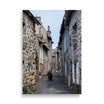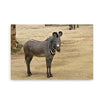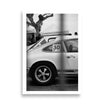Fine art photography: a deep exploration of visual expression
Fine art photography is much more than just capturing images. It is a form of expression, an exploration of creativity and a way of seeing the world through a different lens. But what really distinguishes fine art photography from other forms of photography? Let's dive into this fascinating universe together.
Art photography: an evolving definition
Photography, since its invention in the 19th century, has constantly evolved from a simple documentation tool to a recognized form of artistic expression. But what really characterizes art photography? And how does it differ from other forms of photography?
Beyond simple capture
Fine art photography transcends the simple capture of a moment. It is the fruit of reflection, of an intention. Where traditional photography can seek to faithfully reproduce reality, art photography can distort it, color it, or even reinvent it. She doesn't just show, she tells, she evokes, she challenges.
Expressing a personal vision
Each art photographer has his own signature, his own vision of the world. This vision is a reflection of his experiences, his emotions, his culture. By observing a work of art photography, we enter, in a way, the intimate universe of its author. It is this personal dimension which gives all its depth to the work.
A thoughtful approach
Contrary to popular belief, art photography is not the result of chance. It is the result of a thoughtful approach, of a creative process. The choice of subject, angle, light, composition... Each element is thought out, worked on, sometimes even reworked several times, until the desired result is obtained.
In conclusion on this first part
Art photography is the art of transforming the mundane into the extraordinary, the everyday into poetry. She reminds us that beauty is everywhere, as long as we know how to look at it. And you, how would you define art photography?
Distinctive features of art photography
Art photography is distinguished by several elements that make it unique and differentiate it from other forms of photography. These characteristics are essential to understanding the depth and complexity of this art form.
A clear artistic intention
At the heart of fine art photography is clear intention. The photographer does not aim simply to capture an image, but to convey an emotion, a thought or a story. This intention is often the reflection of deep reflection on a particular subject or theme.
Impeccable technical mastery
If the intention is essential, the technique is no less so. Mastery of lighting, framing, composition, and post-production tools is essential to faithfully translate the artist's vision. It is this technique that allows you to sublimate the subject and give it all its strength.
The constant search for originality
Art photography must be original. She seeks to surprise, to offer a new perspective, to break away from clichés. This originality can be reflected in the choice of subject, the shooting angle, or even the techniques used.
An emotional dimension
More than any other form of photography, art photography seeks to touch, to move. It can provoke joy, sadness, nostalgia, astonishment... This emotional dimension is essential to create a connection between the work and the viewer.
The place of art photography in the global artistic panorama
Art photography, although relatively young compared to other forms of art, has carved out a special place for itself in the artistic world. Its evolution, impact and recognition are worth exploring to understand its current position.
Progressive recognition
At first, photography was primarily seen as a documentary tool, a way of capturing reality objectively. However, over time, artists began to experiment, pushing the boundaries of this medium, transforming it into a form of artistic expression in its own right.
The pioneers of art photography
Names like Ansel Adams, Dorothea Lange, and Henri Cartier-Bresson have left their mark on the history of art photography. Their works, often revolutionary for their time, demonstrated the potential of photography as a means of artistic expression, and not just documentary.
Art photography in institutions
Today, art photography is present in the greatest museums and galleries in the world. Entire exhibitions are dedicated to him, and photographic works fetch astronomical prices at auction. This institutional recognition is a sign of the importance and value given to art photography in the contemporary artistic landscape.
The impact of technology
The advent of digital technology has shaken up the world of photography. While some purists miss the good old days of film, it is undeniable that technology has opened new doors for artists. Photo editing, editing techniques, and even augmented reality offer new possibilities to push the limits of creativity even further.
How to recognize a work of art photography?
Recognizing a work of art photography is not always easy. However, a few things can put you on the path:
- Intention : As mentioned before, fine art photography always has an intention behind it.
- The signature : Often, art photographers sign their works, thus attesting to their originality.
- Limited edition : Works of fine art photography are often produced in limited numbers, thus reinforcing their unique character.
How to get started with art photography?
Immersing yourself in the world of fine art photography can seem intimidating at first. However, with the right resources and a methodical approach, it is entirely possible to learn about this rich and exciting universe. Here are some steps to start your journey into the world of fine art photography.
Train and educate yourself
1. Courses and workshops : Many establishments offer courses dedicated to art photography. Whether in specialist schools, universities or even local workshops, these courses provide a solid foundation for understanding the techniques and concepts of fine art photography.
2. Books and publications : There are countless books dedicated to art photography. From technical manuals to artist monographs, these resources are invaluable for expanding your knowledge.
Practice, practice, practice
As with any art form, practice is key. Grab your camera and get out! Experiment, try different techniques, make mistakes and learn from them.
Join a community
1. Clubs and Associations : Joining a photography club or association can be extremely beneficial. This allows you to meet other enthusiasts, exchange advice and take part in outings or exhibitions.
2. Exhibitions and galleries : Visit art photography exhibitions regularly. It is an opportunity to analyze the work of other artists, to gain inspiration and to understand current trends in the world of art photography.
Develop your personal style
As you immerse yourself in fine art photography, you will begin to develop your own style, your own voice. Don't be afraid to experiment, step out of your comfort zone and look for what makes you unique as an artist.
In conclusion: art photography, an invitation to see the world differently
Art photography invites us to see the world from a different perspective. It pushes us to think, to feel, to question ourselves. It is a reflection of the unique vision of its author, a window open to his universe. So, the next time you are faced with a work of art photography, take the time to contemplate it, to dissect it, to feel it. You may discover a side of the world that you had never considered.






































































Leave a comment
All comments are moderated before being published.
This site is protected by hCaptcha and the hCaptcha Privacy Policy and Terms of Service apply.